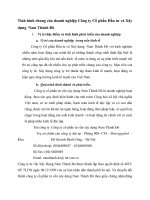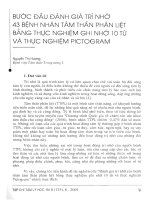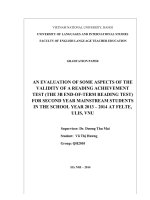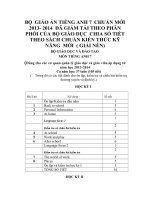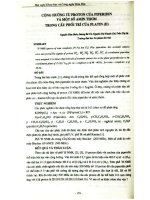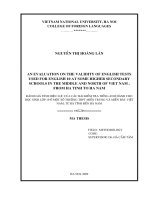ĐÁNH GIÁ MỘT SỐ KHÍA CẠNH TRONG TÍNH GIÁ TRỊ CỦA MỘT BÀI THI HẾT HỌC PHẦN MÔN ĐỌC HIỂU (BÀI THI HẾT HỌC PHẦN MÔN ĐỌC TIẾNG ANH 3B) NĂM HỌC 2013 2014 DÀNH CHO SINH VIÊN NĂM THỨ HAI, HỆ ĐẠI TRÀ, KHOA SƯ PHẠM TIẾNG ANH, TRƯỜNG ĐẠI HỌC NGOẠI NGỮ, ĐẠI HỌC QUỐC
Bạn đang xem bản rút gọn của tài liệu. Xem và tải ngay bản đầy đủ của tài liệu tại đây (585.85 KB, 108 trang )
VIETNAM NATIONAL UNIVERSITY, HANOI
UNIVERSITY OF LANGUAGES AND INTERNATIONAL STUDIES
FACULTY OF ENGLISH LANGUAGE TEACHER EDUCATION
GRADUATION PAPER
AN EVALUATION OF SOME ASPECTS OF THE
VALIDITY OF A READING ACHIEVEMENT
TEST (THE 3B END-OF-TERM READING TEST)
FOR SECOND YEAR MAINSTREAM STUDENTS
IN THE SCHOOL YEAR 2013 – 2014 AT FELTE,
ULIS, VNU
Supervisor: Dr. Dương Thu Mai
Student: Vũ Thị Hương
Group: QH2010
HA NOI – 2014
ĐẠI HỌC QUỐC GIA HÀ NỘI
TRƯỜNG ĐẠI HỌC NGOẠI NGỮ
KHOA SƯ PHẠM TIẾNG ANH
KHÓA LUẬN TỐT NGHIỆP
ĐÁNH GIÁ MỘT SỐ KHÍA CẠNH TRONG TÍNH GIÁ
TRỊ CỦA MỘT BÀI THI HẾT HỌC PHẦN MÔN
ĐỌC- HIỂU (BÀI THI HẾT HỌC PHẦN MÔN ĐỌC
TIẾNG ANH 3B) NĂM HỌC 2013-2014 DÀNH CHO
SINH VIÊN NĂM THỨ HAI, HỆ ĐẠI TRÀ, KHOA SƯ
PHẠM TIẾNG ANH, TRƯỜNG ĐẠI HỌC NGOẠI
NGỮ, ĐẠI HỌC QUỐC GIA HÀ NỘI
Giáo viên hướng dẫn: TS. Dương Thu Mai
Sinh viên: Vũ Thị Hương
Khóa: QH2010
HÀ NỘI – NĂM 2014
ACCEPTANCE
I hereby state that I: Vũ Thị Hương, QH2010.F.1.E1, being a candidate for the
degree of Bachelor of Arts (TEFL), accept the requirements of the College
relating to the retention and use of Bachelor’s Graduation Paper deposited in
the library.
In terms of these conditions, I agree that the origin of my paper deposited in the
library should be accessible for the purposes of study and research, in
accordance with the normal conditions established by the librarian for the care,
loan or reproduction of the paper.
Signature
Hương
Vũ Thị Hương
May 2014
ACKNOWLEGEMENTS
To fulfill this paper I have been fortunate to receive supports and assistance
from a variety of people.
First and foremost, I would like to express my deepest gratitude to Dr.
Dương Thu Mai, my respectful supervisor, who has given the untiring help to my
study. I am truly grateful to her for her advice and suggestions right from the
beginning when this study was only in its formative stage.
I wish to take this opportunity to express my big thanks to Ms. Trần Thị Lan
Anh, my ELT teacher, for her insightful comments and suggestions for this
paper.
I also owe my sincere thanks to the teachers at Division of English skills 2,
FELTE, ULIS, VNU who have been the enthusiastic participants in my research.
Without them, my research could not been completed and successful.
I would like to send my thanks to my teachers, my friends and my
classmates for their sincere comments and criticism as well as encouragement.
In the end, I would like to show my big gratitude to my family, especially
my mother, who have constantly inspired and encouraged me to overcome
difficulties to complete this study.
i
ABSTRACT
Test evaluation is a complicated phenomenon, which has been paid
much attention by number of researchers since the importance of language
tests in assessing the achievements of students was raised. When evaluating a
test, evaluators should focus on criteria of a good test of which validity and
reliability are two important factors. In this current study, researcher chose the
English 3B end-of-term reading test for second year mainstream students at
FELTE, ULIS, VNU in the school year 2013 - 2014 to evaluate with an aim at
checking the content validity and construct validity as well as estimating the
internal reliability of the test. From the interpretation of the data got from the
test scores, survey questionnaires, and test specifications analysis, the
researcher has found out that the English 3B end-of-term reading test is
reliable in the aspect of internal reliability. The content validity has been
checked as well and the test is concluded to demonstrate a relatively high level
of content relevance and show some evidence of the representativeness.
Besides, it is also proved to show structure validity to some extent. However,
the study remains limitations that lead to the researcher’s directions for future
studies.
ii
TABLE OF CONTENTS
ACKNOWLEGEMENT i
ABSTRACT…………………………………………………………………… ii
TABLE OF CONTENTS iii
LIST OF FIGURES AND TABLES ……………………… vii
LIST OF ABBREVIATIONS … …………………………………………… x
PART I: INTRODUCTION…………………………………… 1
1. Statement of research problem and rationale for the study……………… 2
2. Goals and objectives of the study………………………………………… 4
3. Research questions………………………………………………………….4
4. Significance of the study……………………………………………………4
5. Scope of the study ……………………………………………………… 5
6. Methodology of the study………………………………………………… 6
7. The organization of the study……………………………………………….6
PART II: DEVELOPMENT………………………………………………… 7
CHAPTER 1: LITERATURE REVIEW ………………………………………8
1. Key concepts……………………………………………………………….8
1.1. Assessment, measurement, test and evaluation……………………8
1.1.1. Assessment………………………………………………………8
1.1.2. Measurement…………………………………………………….8
1.1.3. Test………………………………………………………………9
1.1.4. Evaluation……………………………………………………… 9
1.2. Test purposes……………………………………………………….10
1.3. Types of test items………………………………………………….11
1.3.1. Objective test items…………………………………………… 12
1.3.2. Subjective test items…………………………………………….13
1.4. English reading achievement tests……………………………… 14
1.4.1. Definition of reading……………………………………………14
iii
1.4.2. The construct of reading performance in English and reading
achievement tests… …………………………………………….15
1.5. The technical quality of reading tests …………………………… 17
1.5.1. Overview of all qualities ……………………………………… 17
1.5.2. Validity………………………………………………………….20
1.5.2.1. Definition of validity……………………………… 20
1.5.2.2. Aspects of validity …………………………………21
1.5.2.3. Factors affecting the validity of reading tests…… 24
1.5.3. Reliability……………………………………………………….25
1.5.3.1. Definition of reliability…………………………… 25
1.5.3.2. Types of reliability………………………………… 26
2. Review of related studies on validity of reading test…………………… 29
2.1. Studies on the validity of reading tests worldwide……………… 29
2.2. Studies on the validity of reading test in Vietnam…………………30
CHAPTER 2: METHODOLOGY …………………………………………… 32
1. The reading assessment context for second year mainstream students at
FELTE, ULIS, VNU……………………………………………………….32
1.1. Test administration procedure…………………………………… 32
1.2. Test specifications………………………………………………… 32
2. Research questions…………………………………………………………38
3. Research Participants and the selection of participants ………………… 39
4. Data collection method…………………………………………………….39
4.1. Survey………………………………………………………………39
4.2. Document observation…………………………………………… 40
5. Data collection procedure………………………………………………….40
5.1. Survey questionnaire……………………………………………….40
5.2. Document observation…………………………………………… 41
6. Data analysis and procedure……………………………………………….42
CHAPTER 3: FINDINGS AND DISCUSSION……………………………… 44
1. Data analysis and results………………………………………………… 44
1.1. Research question 1: The content validity of the test as perceived by
iv
teachers ……………………………………………………………….44
1.2. Research question 2: The structure validity of the test……………61
1.3. Research question 3: The internal reliability of the test ………… 64
2. Findings and discussion…………………………………………………66
2.1. Major findings………………………………………………………66
2.2. Content validity of the test……………………………………….66
2.3. Structure validity of the test…………………………………… 67
2.4. Reliability of the test…………………………………………… 68
PART III: CONCLUSION………………………………………………………69
1. Conclusion and implications……………………………………………70
2. Limitations of the study …………………………………………… 71
3. Suggestions for further research………………………………………… 72
REFERENCES…… ……………………………………………………………73
APPENDICES……………………………………………………………………78
Appendix 1: The 3B end-of-term reading test for second year mainstream students
at FELTE,ULIS, VNU in the school year 2013-2014 ………………………… 79
Appendix 2: Survey questionnaire for teachers.………………………………….88
Appendix 3: Internal reliability calculating results……………………………….90
v
LIST OF FIGURES AND TABLES
FIGURES
Figure 1.1: Relation between evaluation, tests and measurements (Bachman 1990)
…………………………………………………………………………………… 10
Figure 2.1: Bloom’s Taxonomy (Old version) ……………………………………34
Figure 2.2: Bloom’s Taxonomy (Revised version)……………………………… 34
Figure 2.3: Changes in the old and new version of Bloom’s taxonomy………….35
TABLES
Table 1.1: Types of reliability…………………………………………………26
Table 1.2: Range of internal reliability value in Cronbach’s Alpha…………… 28
Table 2.1: Test specifications…………………………………………………… 33
Table 2.2: Revised test specifications…………………………………………… 35
Table 3.1: Teachers’ opinions about the tested skills in questions 71-75……….44
vi
Table 3.2: Teachers’ opinions about the tested skills in questions 76-80……… 45
Table 3.3: Teachers’ opinions about the tested skills in question 81…………….46
Table 3.4: Teachers’ opinions about the tested skills in question 82…………….47
Table 3.5: Teachers’ opinions about the tested skills in questions 83-84……… 47
Table 3.6: Teachers’ opinions about the tested skills in questions 85……………48
Table 3.7: Teachers’ opinions about the tested skills in questions 86-89…………49
Table 3.8: Teachers’ opinions about the tested skills in questions 90-93…………49
Table 3.9: Teachers’ opinions about the tested skills in questions 94-99……… 50
Table 3.10: Teachers’ opinions about the tested skills in questions 100-101……51
Table 3.11: Teachers’ opinions about the tested skills in question 102………….51
Table 3.12: Teachers’ opinions about the tested skills in question 103………….52
Table 3.13: Teachers’ opinions about the tested skills in questions 104-105……52
Table 3.14: Teachers’ opinions about the tested skills in question 106………… 53
Table 3.15: Teachers’ opinions about the tested skills in questions 107-110……54
Table 3.16: Teachers’ opinions about the difficulty level of questions 71-75……54
Table 3.17: Teachers’ opinions about the difficulty level of questions 76-80……55
Table 3.18: Teachers’ opinions about the difficulty level of question 81……… 55
Table 3.19: Teachers’ opinions about the difficulty level of question 82……… 56
Table 3.20: Teachers’ opinions about the difficulty level of questions 83-84……56
Table 3.21: Teachers’ opinions about the difficulty level of question 85……… 56
Table 3.22: Teachers’ opinions about the difficulty level of questions 86-89……57
Table 3.23: Teachers’ opinions about the difficulty level of questions 90-93……57
Table 3.24: Teachers’ opinions about the difficulty level of questions 94-99……58
Table 3.25: Teachers’ opinions about the difficulty level of questions 100-101…58
vii
Table 3.26: Teachers’ opinions about the difficulty level of questions 102………59
Table 3.27: Teachers’ opinions about the difficulty level of question 103………59
Table 3.28: Teachers’ opinions about the difficulty level of questions 104-105…60
Table 3.29: Teachers’ opinions about the difficulty level of question 106………60
Table 3.30: Teachers’ opinions about the difficulty level of questions 107-110…60
Table 3.31: The distribution of the skill tested in the test specifications and the
course guide……………………………………………………………………… 62
Table 3.32: Internal reliability statistics of the test……………………………… 65
viii
LIST OF ABRREVIATIONS
CAE: The Certificate in Advanced English
ELT: English Language Teaching
FCE: The First Certificate in English
FELTE: Faculty of English Language Teacher Education
IELTS: International English Language Testing System
PET: The Preliminary English Test
TOEFL: Test of English as a Foreign Language
ULIS: University of Languages and International Studies
VNU: Vietnam National University, Hanoi
ix
x
PART I: INTRODUCTION
1
1. Statement of research problem and rationale for the study
Assessment plays an important role in the process of teaching and learning.
It provides teachers “the information that is used for making decisions about
students, curricula and programs, and educational policy” (Nitko, 1996). That kind
of information can be collected from assessments through a number of tools such as
tests, students’ diaries, portfolios, etc. Among those tools, testing is an important
tool for educational assessment in general and for language assessment in
particular. According to Heaton (1988), testing can be used as a method to fasten
the relationship between teaching and learning and to motivate students or simply
to assess the language performance of the students. It has a close relationship with
teaching which is “so closely interrelated that it is virtually impossible to work in
either field without being constantly concerned with the other” (Heaton, 1988).
Testing is a tool to “pinpoint strengths and weaknesses in the learned abilities of
the student” (Henning, 1987, p.1). It means that thanks to testing, teachers can
evaluate and assess both their students’ abilities in general and language ability in
particular and the teaching and learning process. At the same time, learners can also
self-evaluate their ability through testing. Thus, Read (1997) states that “a test can
help both teachers and learners to clarify what the learners really need to know.”
Obviously, not only the teachers but also learners may achieve the benefits through
testing. That’s the reason why testing is implemented in schools at different levels
in general and at University of Languages and International Studies, Vietnam
National University, Hanoi (ULIS, VNU) in particular.
In spite of its crucial importance, designing a test is not an easy work.
Sometimes, the content of the tests maybe suitable for this type of learners and their
levels but it is not suitable for other types of learners who are at different levels.
Thus, learners’ abilities may be evaluated inappropriately. In fact, some universities
in Vietnam, a non-native English speaking environment, have to buy the test format
from a prestigious university to have a standardized test. Nonetheless, it is still not
2
fair enough if the original tests are applied for Vietnamese students without any
changes in the test content.
In the context of ULIS, VNU, tests for students are sometimes adapted from
Cambridge University with the tests at various levels such as PET, FCE and CAE
or tests from International English Language Testing System (IELTS) and
Test of English as a Foreign Language (TOEFL). However, there is a fact that what
is tested may not be exactly what is taught in the course because the test is designed
from faraway universities and the levels of students of those universities are
different from the supposed standards of the university, ULIS, VNU. Besides, some
tests are made by teachers themselves. In this case, the tests may not be verified
and thus its quality cannot be assured. In addition, “what test writers are concerned
with seems to be the reliability of the test and its validity” (Le, 2010). That is to
say, reliability and validity are the two most essential qualities of a good language
test. They are also the main considerations of test writers when designing a test.
However, a test may be reliable but not valid. For example, a reading test with
many multiple-choice questions about vocabulary and grammar used in the passage
is reliable; nonetheless, it is not valid because it tests not only students’ reading
skills but also their vocabulary and grammar. It violates rules of testing that assure
test validity. Therefore, “the most important quality to consider in the development,
interpretation, and use of language tests is validity” (Bachman, 1990). Besides,
little research work has been done into evaluating the validity of reading tests at
ULIS, VNU. There is only some research into the validity of writing and speaking
achievement tests such as those done by To (2001) and Dang (2008). Meanwhile,
the importance of reading skill is as cardinal as other skills like listening, speaking
and writing. Thus, evaluating the validity of a reading test also plays a considerable
role in contributing to improve the quality of a test, hence reinforce the relationship
between testing and teaching and learning.
All of the aforementioned reasons have inspired the researcher to carry out this
study to evaluate some aspects of the validity of reading achievement tests for
3
second year mainstream students at FELTE, ULIS, VNU by evaluating an end-of-
term reading test in academic English (3B) for second year mainstream students at
FELTE, ULIS, VNU at the end of the first semester in the school year 2013 - 2014.
Hopefully, the result of the study can then help to improve the quality of the
achievement tests for mainstream sophomores at FELTE, ULIS.
2. Goals and objectives of the study
The study aims at reviewing and analyzing current theories on validity in
order to investigate the validity of a reading achievement test hence identifying
and evaluating the level of validity that the 3B end-of-term reading test has
obtained in terms of content validity, structure validity, and internal reliability.
In addition, the study is also expected to give some suggestions to improve the
flaws, if any, of the current 3B end-of-term reading test for second year
mainstream students at FELTE, ULIS, VNU.
3. Research questions
The study is conducted to answer the following questions:
To what extent is the 3B end-of-term reading test for second year
mainstream students in the school year 2013 - 2014 at FELTE, ULIS,
VNU valid in terms of content validity as perceived by teachers?
To what extent is the 3B end-of-term reading test for second year
mainstream students in the school year 2013 - 2014 at FELTE, ULIS,
VNU valid in terms of structure validity?
What is the internal reliability of the 3B end-of-term reading test for
second year mainstream students in the school year 2013 - 2014 at
FELTE, ULIS, VNU?
4. Significance of the study
Once completed, the study would bring about certain advantages. To be
more specific, the findings of the research would supply to test makers and
teachers in the targeted context some useful information about whether their
inferences about the students are accurate or not and whether how the reading
result is true to students’ ability. Hence, test makers and teachers or testing
experts would get more information about the real situation of testing at
FELTE, ULIS, VNU and thus, find out solutions for the inadequacy, if any, in
the test’s content and structure. In addition, the research would also be a source
4
of references for further research in the same field.
5. Scope of the study
Firstly, in this paper the researcher emphasizes the reading achievement tests
instead of investigating other kinds of tests such as replacement tests or
diagnostic tests. Secondly, the exploration of other language skills like writing,
listening and speaking is not included in this study. Furthermore, within the
scope of graduation paper, only two aspects of validity, including content and
structure validity, together with the internal reliability of the test are studied. It
is said that content and structure are two of the most important aspects of the
validity of a test; moreover, internal reliability is also a crucial factor in
evaluating the quality of a test. The consistency within test items contributes a
great part in the quality of a good test. Thirdly, due to the limitation of time and
experience, the study is carried out only with a reading achievement test in
English 3B Course – English for Academic Purposes for a group of second year
mainstream students at FELTE, ULIS, VNU. The researcher chooses this group
of sample among the four school years at university as the second year is said to
be the most significant in the new local curriculum. It is the last year that the
students study with a common curriculum before they specialize into different
types of major dimension. In addition, English 3B is more useful and
fundamental for academic purposes than English 3A and 3C, which are English
for Social Purposes and English for Standardized Testing Purposes respectively.
Thus, the researcher decides to study only the 3B reading achievement test of
second year mainstream students at FELTE, ULIS, VNU.
The study provides empirical evidence of the current reading achievement
tests and proposes practical suggestions on the improvement of the end-of-term
reading test for ULIS second year students in general.
6. Methodology of the study
In this study, the test is evaluated by adopting both qualitative and
quantitative methods. The research is quantitative in the sense that the data
will be collected through the analysis to the scores of the 100 random test
5
papers of students at FELTE, ULIS. To calculate the internal reliability
researcher uses Cronbach’s Alpha formula via SPSS 16.0 software. It is
qualitative in the aspect of using open-ended survey questionnaires which
were delivered to teachers at Division II, FELTE, ULIS,VNU and the
comparison of the test specification with the lesson objectives in the
English 3B course guide. The conclusion to the analysis and the comparison
would be used as the qualitative data of the research.
7. The organization of the study
The study is divided into three parts:
Part I: Introduction – is the presentation of basic information such as the
statement of research problem, the rationale, the scope, the objectives, the
methodology, and the organization of the study.
Part II: Development – This part consists of three chapters
Chapter 1: Literature Review – in which the literature that related to
language of testing and test evaluation.
Chapter 2: Methodology – is concerned with the methods of the study,
the selection of participants, the materials and the methods of data
collection and analysis as well the results of the process of data analysis.
Chapter 3: Results and Findings - in which the results of the study is
presented and analyzed; and some findings are also reported.
Part III: Conclusion – this part will be the summary to the study,
limitations as well the recommendations for further studies.
6
PART II: DEVELOPMENT
CHAPTER 1: LITERATURE REVIEW
This chapter is an attempt to establish the theoretical background for the study.
The key concepts of language testing including measurement, tests and evaluation,
validity and reliability and some related studies worldwide and in Vietnam will be
reviewed.
7
1. Key concepts
1.1. Assessment, measurement, test and evaluation
The terms “assessment”, “measurement”, “test” and “evaluation” are sometimes
used as synonyms and in reality they can mention to the same activity (Bachman,
1990). For example, when someone is asked about his or her evaluation of a
student, he or she often gives the test score of that students and bases on that to
evaluate the student. However, they still have some distinctive features.
1.1.1. Assessment
According to Nitko (1996), assessment is “a broad term defined as a process
for obtaining information that is used for making decisions about students,
curricula and programs, and educational policy.” For example, basing on
assessment, teachers can make decisions about managing classroom instruction,
placing students into different types of educational programs, assign them to
appropriate categories or making decisions about the effectiveness of the programs
or solutions to improve them (Nitko, 1996). Because assessment is a broad term, it
can be drawn that assessment refers to all methods used to gather information about
learner’s knowledge and skills. Shortly speaking, “assessment is a broader term
than test or measurement, because not all types of assessments yield
measurements.” (Nitko, 1996)
1.1.2. Measurement
Bachman (1990) states that measurement, in the social science, is “the
process of quantifying the characteristic of persons according explicit procedures
and rules.” Nitko (1996) clarifies measurement is “a procedure for assigning
numbers to a specific attribute or characteristic of a person in such a way that the
numbers describe the degree to which the person possesses the attribute.” From
these points of view, it is shown that measurement is a method of interpreting
number to find out the attribute of a subject. Due to its features, measurement is
essential in language teaching and learning.
8
1.1.3. Tests
According to Carroll (1968, cited in Bachman, 1990), test is defined as
below:
A psychological or educational test is a procedure designed to elicit
certain behavior from which one can make inferences about certain
characteristics of an individual.
From this definition, Bachman (1990) states that a test is one type of
measurement that is designed to “elicit a specific sample of an individual
behavior”. However, he also adds that the distinction between a test and other types
of measurement is that it is used to obtain a particular action. Obviously,
measurement is a broader concept than a test. A test, as stated above, is just a tool
for assessment or measurement.
1.1.4. Evaluation
Nitko (1996) gives the definition of evaluation as “the process of making a
value judgment about the worth of a student’s product of performance.” At this
point, he emphasizes the relationship between students’ behaviors and the judgment
on them. At the same point, Genesee and Upshur (1996) claim that evaluation is
basically about making decision. This is also the view of Weiss (1972, cited in
Bachman, 1990) in which evaluation is “the systematic gathering of information for
the purpose of making decisions.” However, evaluation may be separated from
tests and measurements. In this situation, evaluation might be carried without any
test or measurement because “evaluation may or may not be based on
measurements or test results” (Nitko, 1996). As such, evaluation “does not
necessarily entail testing” (Bachman, 1990). The relationship between evaluation,
tests and measurement is represented in the chart below:
9
Figure 1.1: Relation between evaluation, tests and measurements
(Bachman, 1990)
As can be seen from the graph, evaluation and measurement are two different
notions but they still have some common features. Furthermore, testing is a method
of measurement and hence tests also have some shared characteristic with
evaluation. In a nutshell, evaluation, measurement and tests always have a close
relationship with each other and they are essential components of language testing.
1.2. Test purposes
There are various ways to classify test purposes. Wiersma and Jurs (1990)
suggest a list of test purposes about the tasks that a test is expected to perform.
Description: Many tests are developed to describe the current status of
individuals on a wide range of variables.
Prediction: It means that some tests are used for the purpose of predicting
examinees’ performance in the future.
Assessing individual differences: Some tests are used to differentiate
between people in order to identify those who are the highest and those who
are the lowest on some measures.
10
Objectives evaluation: Some tests are used to report progress of the students
compare with the objectives of a course or a program and to plan instruction
in terms of the objectives.
Domain estimation: For this purpose, many tests are designed to estimate the
percentage of a domain that the student understands.
Mastery decisions: Some tests need to be constructed in such a way that
mastery and non-mastery are unambiguously determined and the masters
and non-masters are clearly separated by test scores
Diagnosis: Many tests are designed to diagnose the students’ strength and
weakness through test performance, or to be more specific, through test
score on one or more tests.
Pre- and Post-assessment: “The purpose of many tests is to document the
gains that students have made in school” (Wiersma & Jurs, 1990). That is to
say, the tests in this case focus on the change in the status or the score of
test-takers in the pre-test and the post-test.
These purposes are the bases for classifying test types. Basing on the purposes
of the test, test designers give the appropriate name for the tests, design test
specifications and let test takers do the tests.
1.3. Types of test items
According to Brown (1996), an item in a language test is “the smallest unit that
produces distinctive and meaningful information on a test or rating scale.” This
definition has already shown the use of test items and its importance in a test. It is a
basic unit of a test. There are different types of test items. Nonetheless, they may be
grouped into two main groups of test items that are objective and subjective test
items.
1.3.1. Objective test items
Objective test items are items that can be marked objectively. They include
multiple choice questions, true-false items and matching items. Subjective test
11
